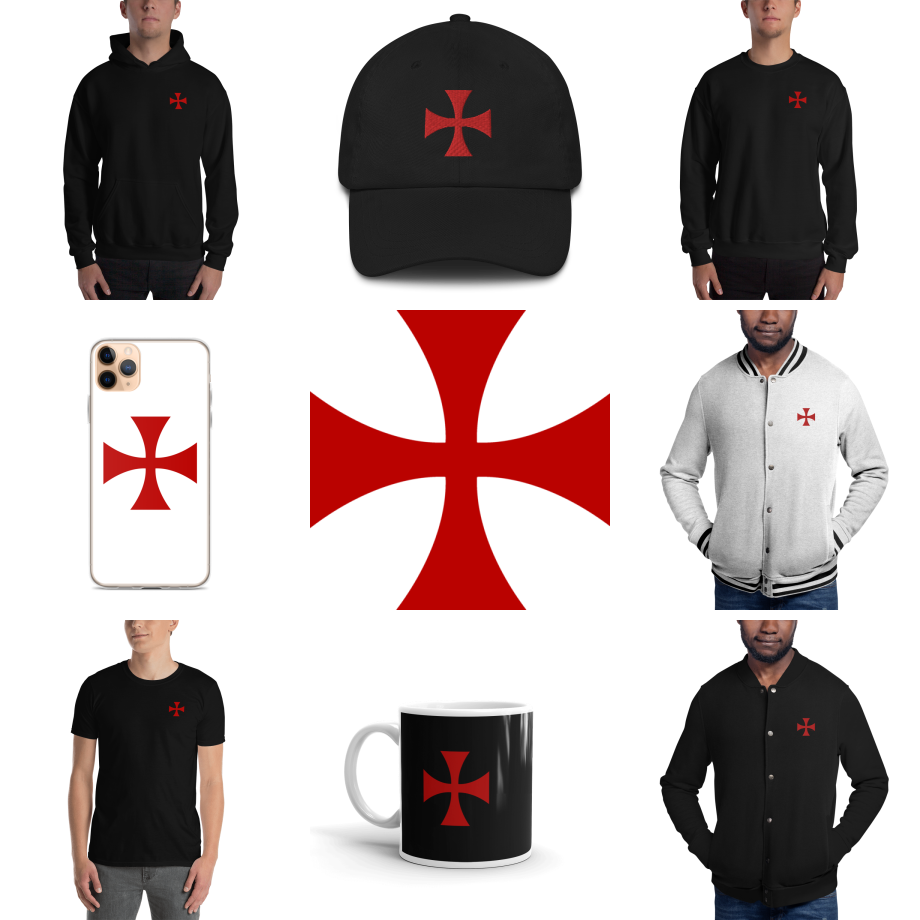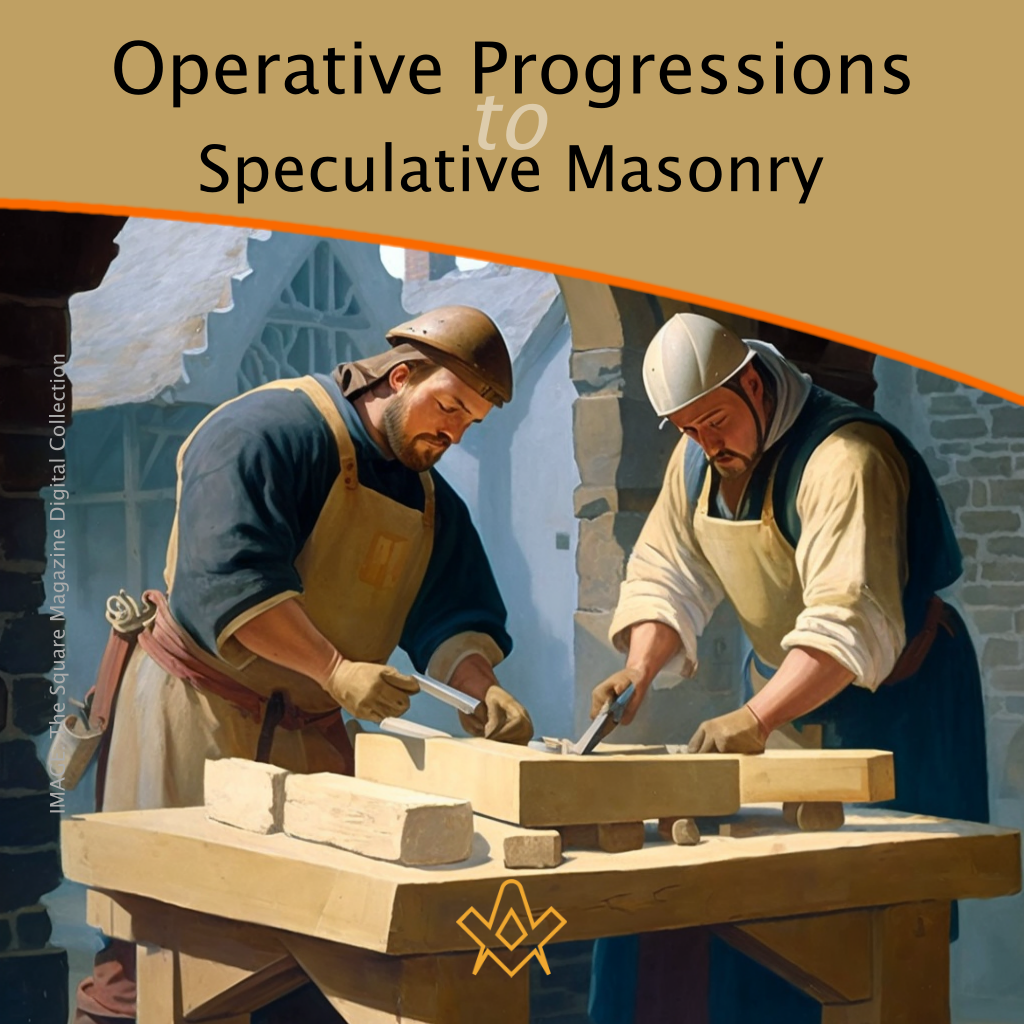Both Operative and Speculative Masonry are an important part of the modern fraternity of Freemasonry, which combines elements of both traditions.
Today, Freemasonry is a fraternity that is open to men of good character, who are interested in personal development and in making a positive contribution to their communities.
Operative Masonry refers to the practical application of the tools, skills, and principles of stonemasonry, such as building and constructing buildings, bridges, and other structures.
This was the original purpose of the fraternity of Masons, also known as the “Craft,” and it dates back to the Middle Ages.
Speculative Masonry, on the other hand, refers to the philosophical and symbolic interpretation of the tools and principles of operative Masonry.
It is called “speculative” because it involves contemplation and speculation about the deeper meanings and lessons that can be drawn from the Craft.
Speculative Masonry began to develop in the seventeenth and eighteenth centuries, as a way for non-stonemasons to become involved in the fraternity and to learn from the principles and traditions of the Craft.
Operative Masonry
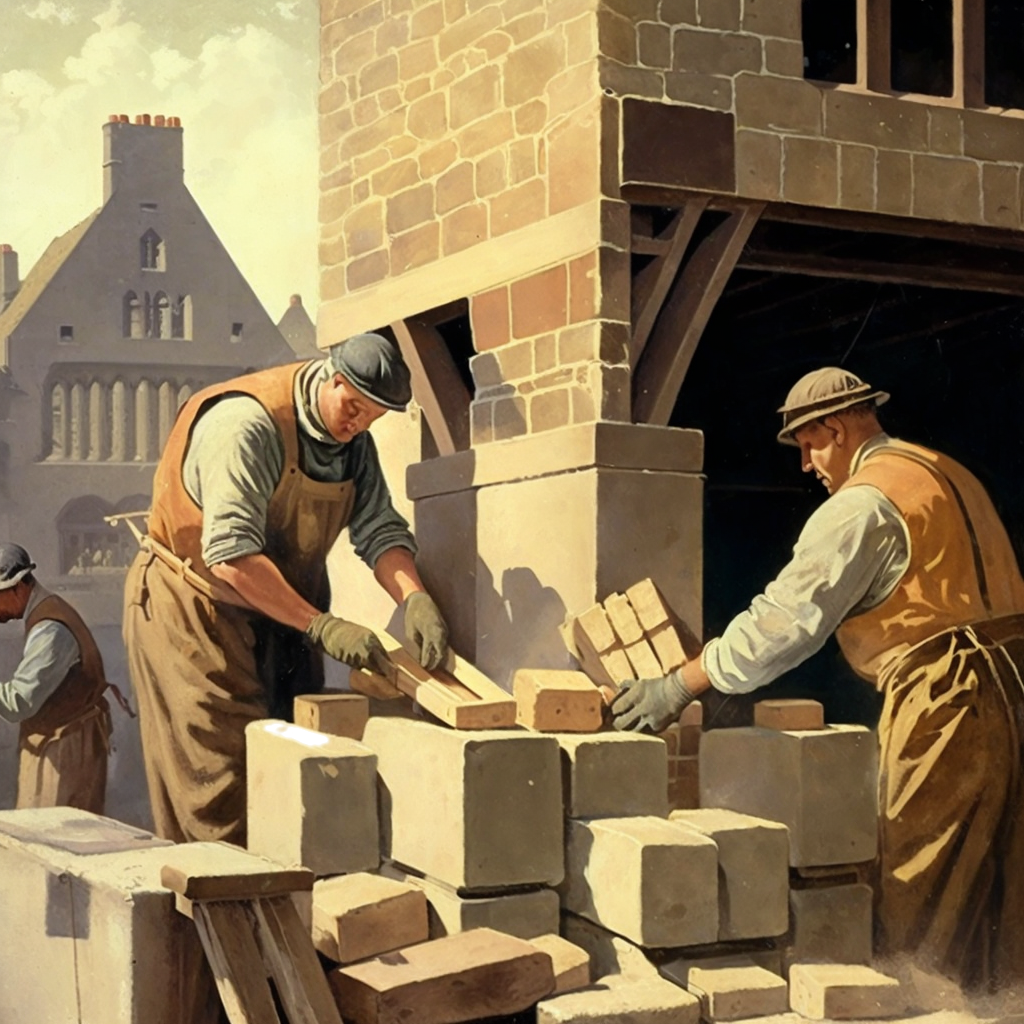
Operative Stonemasons
IMAGE CREDIT: the square magazine digital collection
The practice of Operative Masonry, which refers to the practical application of the tools, skills, and principles of stonemasonry, dates back to the Middle Ages.
Stonemasonry has a long history, with evidence of its use dating back to ancient civilizations such as the Egyptians, the Greeks, and the Romans.
During the Middle Ages, the craft of stonemasonry was an important part of the construction industry, and Masons played a crucial role in building many of the castles, churches, and other structures that still stand today.
The fraternity of Masons, also known as the “Craft,” developed during this time as a way for Masons to organize and regulate their trade, and to ensure that the highest standards of quality and craftsmanship were maintained.
Over time, the practice of operative Masonry has evolved and changed, but it remains an important part of the modern construction industry, and Masons continue to play a vital role in the building and maintenance of many of the structures that we rely on in our daily lives.
In the Middle Ages, craft guilds played an important role in the practice of operative Masonry. A craft guild was a type of organization that brought together workers in a particular trade or craft, such as Masons, carpenters, blacksmiths, and so on.
Guilds were formed in order to regulate and protect the interests of the workers in a particular craft, and they played a number of important roles in medieval society.
One of the primary functions of craft guilds was to set standards for the quality of work produced by their members.
Guilds would often establish rules and regulations governing the materials, methods, and techniques used in a particular craft, and they would enforce these rules through a system of fines and other penalties.
Guilds were also responsible for training new workers in the skills of their craft, and for passing on the traditions and knowledge of their trade from one generation to the next.
In the case of Operative Masonry, the craft guilds played a particularly important role, as they helped to ensure that the highest standards of quality and craftsmanship were maintained in the construction of castles, churches, and other structures.
Guilds also provided a way for Masons to organize and advocate for their rights and interests, and they helped to establish the craft of stonemasonry as a respected and valued profession. Overall, the craft guilds were an important part of the practice of Operative Masonry during the Middle Ages, and they continue to have an influence on the modern construction industry to this day.
There were several Royal Acts or Statutes passed with relation to labourers:
Statute of Laborers [1351]
In response to a labour shortage, the English parliament under King Edward III passed the Statute of Labourers in 1351. Its goal was to control the labour force by preventing requests for or offers of wages greater than those in place before the Black Death and restricting travel in search of better working circumstances.
Read more about the Statute of Labourers Act
Statute of Artificers and Apprentices [1563]
“An Acte towching dyvers Orders for Artificers Laborers Servantes of Husbandrye and Apprentises” (1563)
A regulation of labour, which sought to banish idleness, advance husbandry, and yield ‘a convenient proportion’ of wages. Growing concern at the number of masterless men, increasing vagabondage, and escalating crime underlay the outline of terms and conditions of service between masters and servants, in an effort to reduce notorious discord.
Source: Encyclopedia.com
Apprenticeship: The statute established new rules governing apprenticeship and training in the construction industry, including the length of time that an apprentice had to serve, the duties that they were required to perform, and the conditions under which they could be released from their apprenticeship.
Regulation of wages: The statute set new rules governing the wages that could be paid to workers in the construction industry, including provisions for minimum wages and for the payment of overtime.
Regulation of working hours: The statute established new rules governing the hours of work for workers in the construction industry, including provisions for rest periods and breaks.
Regulation of the construction industry: The statute established a central authority for regulating the construction industry, which was responsible for enforcing the rules and regulations set forth in the statute.
While the guilds were still able to operate in a limited capacity, they lost much of their former power and influence, and the construction industry became more closely tied to the crown and to the state. Overall, the changes implemented by Elizabeth I had a lasting impact on the craft guilds in operative Masonry, and they helped to shape the modern construction industry as we know it today.
Read the full Statute of Artificers 1563
Example Construction Projects
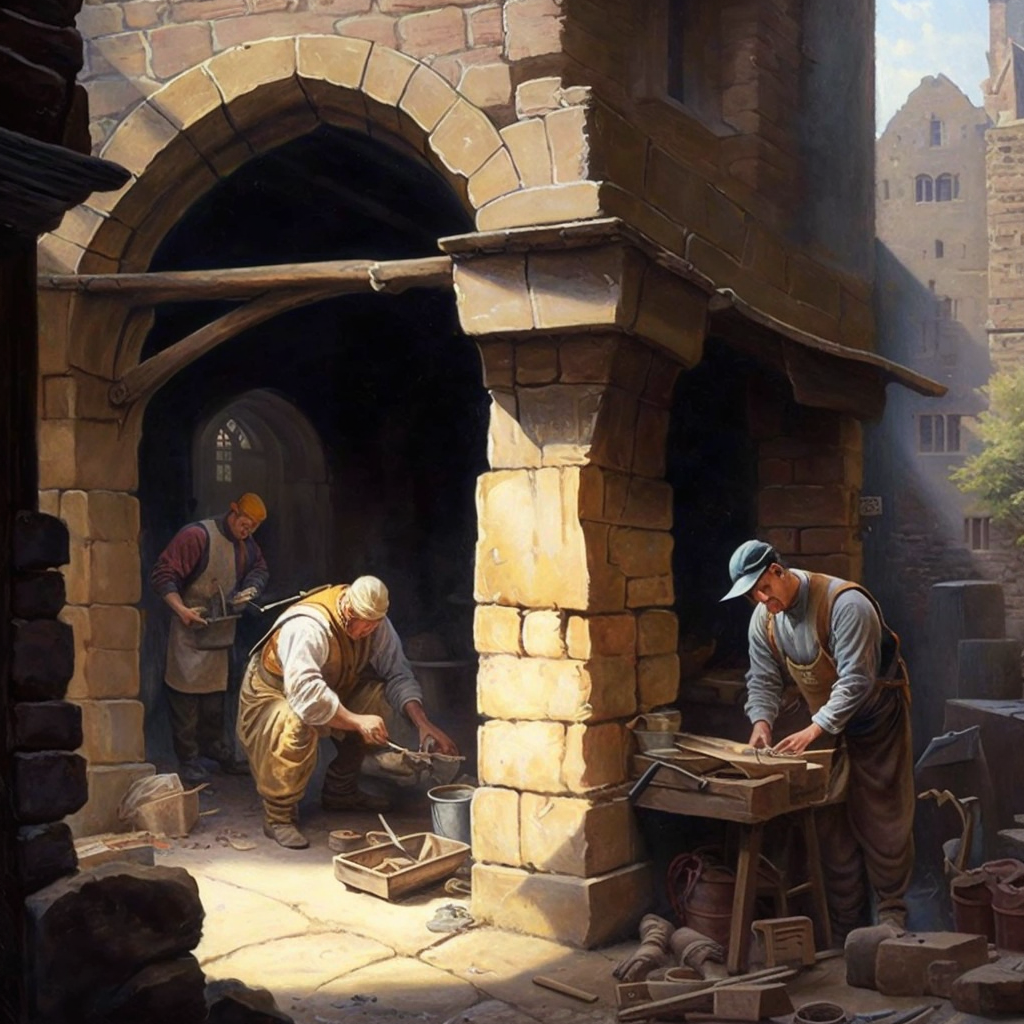
construction work on civic building
IMAGE credit: the square magazine digital collection
Building a bridge: Masons working in operative Masonry would be involved in the construction of a bridge, using their skills and knowledge of stonemasonry to lay the foundation, build the pillars and arches, and create the roadway.
Constructing a castle or fortification: building the walls and towers of a castle or other fortification, using their expertise in working with stone to create strong, durable structures.
Erecting a monument: the construction of a monument, such as a statue or obelisk, using their skills in sculpting and carving stone to create the desired shape and form.
Building a church or temple: constructing of a place of worship, such as a church or temple, using their expertise in working with stone to create the foundation, walls, and other structural elements.
Tools used by Operative Masons in the Middle Ages
Chisels: Chisels were used to shape and carve stone, either by hand or with the help of a hammer.
Hammers: Hammers were used to strike chisels and other tools, as well as to shape and mold the stone.
Trowels: Trowels were used to smooth and finish the surface of the stone, as well as to apply mortar when building with brick or stone.
Levels: Levels were used to ensure that a surface was horizontal or vertical, and to ensure that structures were built to be properly balanced and stable.
Compasses: Compasses were used to draw circles and arcs, as well as to create precise angles and curves.
Plumb bobs: Plumb bobs were used to ensure that structures were built vertically, and to ensure that walls and other surfaces were perfectly straight.
Squares: Squares were used to ensure that surfaces were at right angles to each other, and to create precise corners and edges.
How Speculative Masonry developed out of the Craft Guilds
Speculative Masonry developed out of the craft guilds, which were organizations that brought together workers in a particular trade or craft, such as Masons, carpenters, blacksmiths, and so on.
The craft guilds played a number of important roles in medieval society, including regulating the quality of work produced by their members, training new workers in the skills of their craft, and passing on the traditions and knowledge of their trade from one generation to the next.
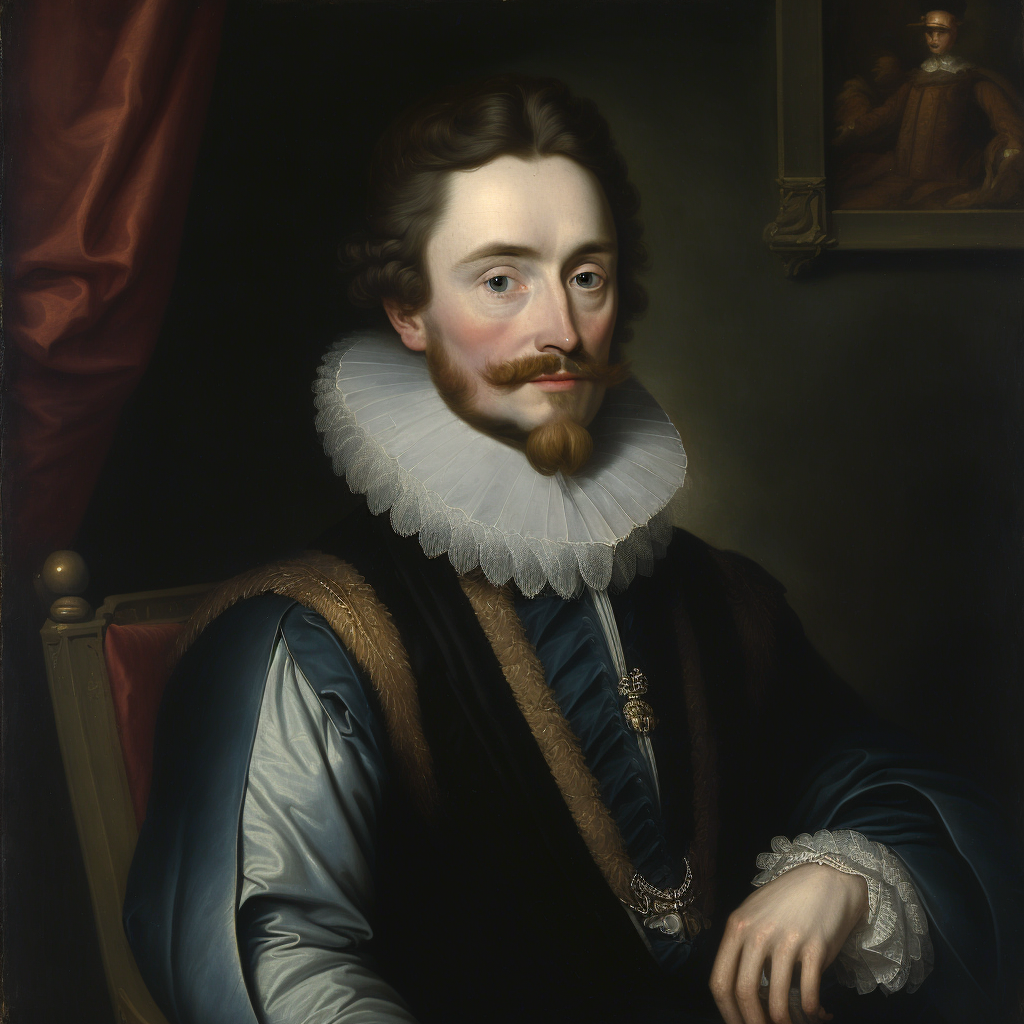
seventeenth centruy gentlemen free-mason
IMAGE linked: wikimedia Attribution 4.0 International (CC BY 4.0)
Speculative Masonry began to develop in the seventeenth and eighteenth centuries, as a way for non-stonemasons to become involved in the fraternity and to learn from the principles and traditions of the Craft.
This development was made possible, in part, by the decline of the craft guilds and the rise of a more centralized system of regulation for the construction industry, which had begun with the passage of the Statute of Artificers by King Henry VIII in 1546.
With the decline of the guilds, the traditions and knowledge of the craft of stonemasonry were no longer as closely guarded, and non-stonemasons were able to learn more about the Craft and to become involved in the fraternity.
This led to the development of speculative Masonry, which involved the philosophical and symbolic interpretation of the tools and principles of operative Masonry.
Overall, the development of speculative Masonry was closely linked to the evolution of the craft guilds and the changing nature of the construction industry, and it represented a new way for people to become involved in the fraternity and to learn from the principles and traditions of the Craft.
Speculative Masonry refers to the interpretation of the tools, symbols, and principles of operative Masonry in a philosophical and symbolic way. This interpretation is based on the belief that the tools, symbols, and principles of the Craft can be used as a metaphor for personal and spiritual growth, and that they can be used to teach lessons about morality, ethics, and the importance of living a good life.
For example, the tools of the Craft, such as the chisel, the hammer, and the trowel, are often used symbolically to represent different virtues or qualities that Masons are encouraged to develop, such as honesty, integrity, and hard work.
Similarly, the principles of the Craft, such as the importance of balance, proportion, and symmetry, are often interpreted as teachings about the importance of living a balanced and harmonious life.
The concept of living a balanced and harmonious life is central to many philosophical and spiritual traditions, and it is also an important principle in Freemasonry. Living a balanced and harmonious life can be interpreted in many different ways, but at its core it means striving for harmony and balance in all aspects of one’s life.
Maintaining a balance between work and leisure: It is important to find a balance between the time and energy that we devote to our work and the time and energy that we devote to rest, relaxation, and personal pursuits.
Achieving balance in our relationships: It is important to maintain healthy, positive relationships with the people in our lives, and to avoid letting any one relationship become overly dominant or unhealthy.
Finding balance in our personal habits and behaviours: It is important to strive for balance in the way that we care for ourselves and our bodies, and to avoid letting any one aspect of our health or well-being become neglected.
Seeking balance and harmony in the world around us: We can also strive for balance and harmony in the way that we interact with the world around us, by being mindful of our impact on the environment and by working to create positive change in our communities.
Overall, living a balanced and harmonious life can help us to lead more fulfilling, meaningful, and satisfying lives.
Through the study and contemplation of these symbols and principles, Masons are encouraged to reflect on their own lives and to strive to become better people. This process of reflection and self-improvement is at the heart of speculative Masonry.
Self-improvement is at the heart of Speculative Masonry
Reflection and self-improvement are an integral part of speculative Masonry, as they are seen as essential for personal growth and for living a good life. The process of reflection involves taking time to think about one’s actions, beliefs, and values, and to consider how they align with one’s goals and aspirations.
Through this process of reflection, Masons are encouraged to identify areas of their lives where they might be able to make positive changes or improvements, and to develop a plan for how to achieve these changes. This might involve setting specific goals or making a commitment to work on a particular area of personal development.
Self-improvement, in turn, refers to the process of actively working to make positive changes in one’s life, based on the insights and goals that have been identified through reflection. This might involve adopting new habits or behaviours, learning new skills, or working to overcome challenges or obstacles.
By engaging in regular reflection and self-improvement, Masons are encouraged to grow as individuals and to live more fulfilling and meaningful lives. This process is at the heart of speculative Masonry, as it helps Masons to align their actions with their values and to strive to become the best versions of themselves.
Both operative and speculative Masonry are an important part of the modern fraternity of Freemasonry, which combines elements of both traditions. Today, Freemasonry is a fraternity that is open to men of good character, who are interested in personal development and in making a positive contribution to their communities.
The Core Principles and Values of Freemasonry
Freemasonry is a fraternity that is based on a set of core principles and values, which are intended to guide the behaviour and conduct of its members. Some of the core principles and values of Freemasonry include:
Brotherhood: Freemasonry emphasizes the importance of brotherhood and the bonds of friendship that exist among its members. Masons are encouraged to treat each other with respect and kindness, and to support each other in times of need.
Moral character: Freemasonry places a strong emphasis on the importance of personal character, and Masons are expected to be men of good moral character. This includes being honest, trustworthy, and dependable, as well as being respectful and considerate of others.
Personal growth: Freemasonry encourages its members to strive for personal growth and development, and to work to become the best versions of themselves. This includes being open to new ideas and experiences, and being willing to learn and grow.
Service to others: Freemasonry is a fraternity that places a strong emphasis on service to others, and Masons are encouraged to be active and engaged members of their communities, and to work to make a positive difference in the world.
Respect for diversity: Freemasonry promotes respect for diversity and for the rights and beliefs of others, and Masons are expected to be tolerant and accepting of people from all walks of life.
Overall, the core principles and values of Freemasonry are intended to help Masons to live good and meaningful lives, and to be positive and constructive members of their communities.
Short History of English Freemasonry
Freemasonry has a long and complex history, with the origins of the fraternity dating back to the Middle Ages. Here is a brief timeline of the history of English Freemasonry:
Late 1600s: The first known record of a Masonic meeting in England is recorded in the diary of Elias Ashmole, who attended a meeting of the “Company of Masons” in Warrington in 1646.
1717: The first Grand Lodge of England is formed in London, with the intention of bringing together and regulating the various Masonic lodges that had been established in the city. This marks the beginning of organized English Freemasonry as we know it today.
1723: The first published version of the “Book of Constitutions,” which outlines the rules and regulations of the fraternity, is published.
1730s: Freemasonry begins to spread beyond London and the south of England, with lodges being established in other parts of the country.
Late 1700s: Freemasonry becomes increasingly popular, with lodges being established throughout the British Isles and around the world.
Late 1800s: The first lodges for women are established, leading to the development of co-freemasonry, which allows both men and women to be members of the fraternity.
The United Grand Lodge of England (UGLE) was formed in 1813 when the Grand Lodge of England and the Grand Lodge of Ancient York Masonry merged.
This merger united the two main strands of Freemasonry in England and established the UGLE as the governing body for Freemasonry in England, Wales, and the British overseas territories.
The UGLE is the oldest Grand Lodge in the world, and its formation played a significant role in the standardization and organization of the Masonic fraternity.
The Four Lodges who started the Premier Grand Lodge of England in 1717 in London
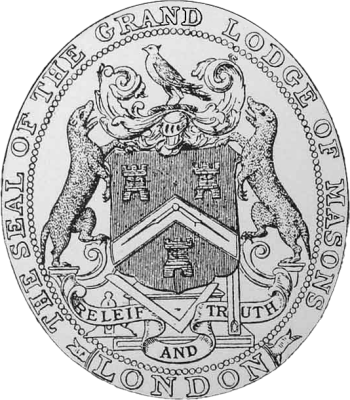
Seal used by Premier Grand Lodge of England on their earliest Masonic certificates. J. Ramsden Riley – Quatuor Coronatorum Antigrapha Vol VIII 1891.
IMAGE LINKED: wikimedia Attribution 4.0 International (CC BY 4.0)
The first Grand Lodge of England, which was established in London in 1717, was founded by a group of four individuals who are known as the “four old lodges.” These four lodges were:
The Goose and Gridiron Ale House Lodge: This lodge was founded in 1708, and was based at the Goose and Gridiron Ale House in St. Paul’s Churchyard.
The Crown Ale House Lodge: This lodge was founded in 1714, and was based at the Crown Ale House in Parker’s Lane, near Drury Lane.
The Apple Tree Tavern Lodge: This lodge was founded in 1716, and was based at the Apple Tree Tavern in Charles Street, Covent Garden.
The Rummer and Grapes Tavern Lodge: This lodge was founded in 1717, and was based at the Rummer and Grapes Tavern in Channel Row, Westminster.
These four lodges came together in 1717 to form the first Grand Lodge of England, with the intention of bringing together and regulating the various Masonic lodges that had been established in London.
The Grand Lodge was established as a way to provide a central authority for the fraternity, and to set standards and regulations for the lodges that were affiliated with it.
The Grand Masters of the first Grand Lodge of England in 1717 in London
The Grand Lodge of England, also known as the Premier Grand Lodge of England, was founded in 1717 in London.
The four men who played key roles in the establishment of this organization were Anthony Sayer, George Payne, John Theophilus Desaguliers, and John Montagu.
Sayer was the first Grand Master of the Grand Lodge of England, serving from 1717 to 1718. Desaguliers, Paynes and Montagu were also Grand Masters of the Grand Lodge at various times.
The Grand Lodge of England is the oldest continuously operating Grand Lodge in the world and played a key role in the development and spread of Freemasonry.
Anthony Sayer
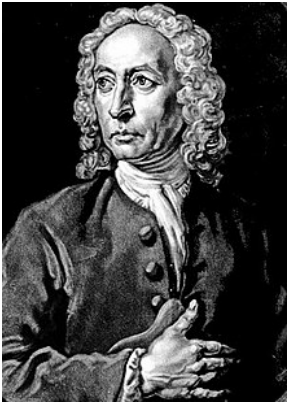
Anthony Sayer, the first Grand Master of the Premier Grand Lodge of England. 1749/50 copy of lost portrait by Joseph Highmore (edited) – print by John Faber the Younger.
IMAGE LINKED: wikimedia Attribution 4.0 International (CC BY 4.0)
Anthony Sayer (c.1672 – 1741), was elected as the first Grand Master on 24 June 1717 (the Feast of St. John the Baptist), at the formation of the Premier Grand Lodge of England of Freemasons at London.
He further served Grand Lodge as Senior Grand Warden under John Theophilus Desaguliers.
Not much is known about Sayer’s life or career, but he was a prominent member of the London Masonic community and was highly respected by his peers.
John Theophilus Desaguliers
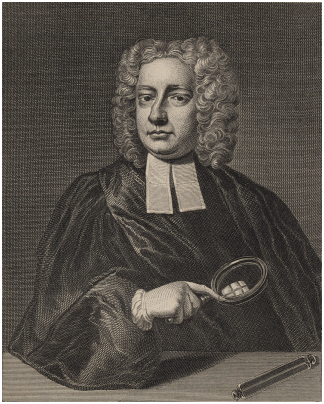
John Desaguliers, third Grand Master of the Premier Grand Lodge of England. Public Domain image.
IMAGE LINKED: wikimedia Attribution 4.0 International (CC BY 4.0)
John (Jean) Theophilus Desaguliers was a prominent member of the early Masonic community and played a key role in the development of Freemasonry.
He was born in La Rochelle, France in 1683 and later moved to England, where he became a member of the Royal Society and a respected scientist and natural philosopher.
Desaguliers was instrumental in the formation of the first Premier Grand Lodge of England serving as Grand Master in 1719-1720.
Desaguliers is known for his contributions to the development of the ritual and ceremonies of Freemasonry, and is credited with introducing the Degree of Master Mason into the fraternity.
He was also an advocate for the adoption of the “Antient” Constitution of the Masons, which was a set of rules and regulations for the governance of the fraternity that were adopted by the Grand Lodge of England.
In addition to his work in Freemasonry, Desaguliers was a well-respected scientist and natural philosopher and made important contributions to the fields of physics and mechanics.
George Payne
George Payne (1685-1757), an English official of the Exchequer, served as the second Grand Master of the Grand Lodge of England in 1718 and again in 1720 after Jean Desagulier’s mastership.
During this time, he compiled ‘The Regulations of a Free Mason’, which were included in James Anderson’s 1723 Constitutions.
Payne was deputy Master in 1725, when Charles Lennox, 2nd Duke of Richmond was both Master of the Lodge and Grand Master.
He was highly regarded with many notable achievements within his lengthy Masonic career recorded in the various Minutes of Grand Lodge.
However, very little is known of Payne’s life in general aside from a few references to his work for the Exchequer and some information regarding his early association with Jean Desaguliers prior to the formation of Grand Lodge.
John, 2nd Duke of Montagu
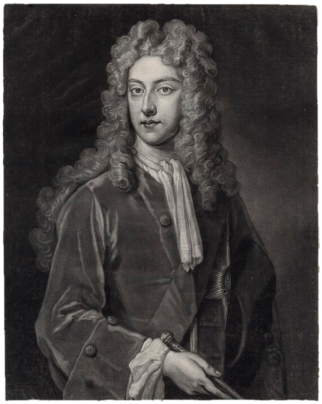
John Montagu, 2nd Duke of Montagu (1690-1749)
IMAGE LINKED: wikimedia Attribution 4.0 International (CC BY 4.0)
John Montagu, 2nd Duke of Montagu (1690-1749) was a British peer and a Fellow of the Royal College of Physicians; he served as the fourth Grand Master of the Grand Lodge of England from 1721-1723; he was the first nobleman to take the role.
The Constitutions of 1723 is dedicated to the Duke and it has been noted that his high regard and noble status caused Freemasonry to flourish and increase in membership during his year as Grand Master.
Montagu was a well-respected member of the Masonic community and was known for his contributions to the fraternity and society at large.
He was instrumental in the creation of the Foundling Hospital, in London, in 1739; the first home for abandoned children.
Philip, 1st Duke of Wharton
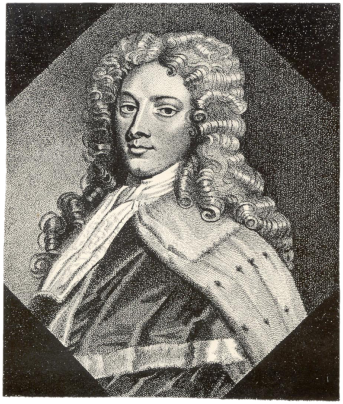
Philip Duke of Wharton. Public Domain.
IMAGE LINKED: wikimedia Attribution 4.0 International (CC BY 4.0)
Philip Wharton, 1st Duke of Wharton (1698–1731) was a powerful Jacobite politician.
He served as the Grand Master of the Grand Lodge of England from 1723 to 1724. He was an active peer in the House of Lords.
After successive failures in business and substantial financial losses, Wharton moved to Spain to join the Jacobite Spanish army fighting the English.
Taking up arms against his native country warranted a charge of treason in 1729.

Philip, Duke of Wharton
Who was Philip, Duke of Wharton and was he Freemasonry’s Loose Cannon Ball ?
more….
The Aims of Speculative Freemasonry
• promotes a set of moral and ethical values, including respect for others, charity, integrity, and personal responsibility. These values can have a positive impact on an individual’s behaviour and contribute to the overall well-being of society.
• encourages its members to be active and engaged members of their communities, and many Masonic organizations support local charities and community service projects.
• promotes education and lifelong learning. Many Masonic lodges offer educational programs and opportunities for their members to learn and grow.
• fosters a sense of brotherhood and camaraderie among its members. This can provide a supportive network for individuals and help to build strong communities.
• encourages its members to be involved in their communities and to take an active role in addressing social issues.
• promotes philanthropy and charitable giving. Many Masonic organizations support various charitable causes, both financially and through volunteer work.
• provides opportunities for personal growth and self-improvement. Through the study of its principles and participation in its activities, members can develop important life skills and a greater sense of purpose.
• encourages good citizenship and responsible leadership. Its principles of integrity and personal responsibility can help to develop strong leaders in communities and organizations.
promotes a sense of history and tradition. It has a long and rich history dating back centuries, and its ceremonies and symbols provide a connection to this history and a sense of continuity with the past.
Freemasonry is a diverse and inclusive organization, welcoming people of all backgrounds and beliefs. This inclusivity can help to promote understanding and harmony among different groups in society.
Recent Articles: masonic history
 Protestantism and Masonic Influence in Brazil Discover the untold story of how Freemasons helped Southern Americans immigrate to Brazil post-Civil War, fostering economic and educational growth in Santa Bárbara d’Oeste and Americana. Learn about their pivotal role in establishing Protestant churches and ensuring the secularity of the Brazilian State amidst a Catholic-dominated society. |
 Explore the proper use of the sacred word in Brazilian Freemasonry through an analysis of Masonic literature and Bible translations. Uncover the errors in pronunciation and the need for corrections to maintain liturgical coherence in rituals. Discover insights on Masonry, rituals, and the Hebrew word Boaz. |
 Narratives of History |
 A Very Royal Sesquicentenary |
 Unveiling the Enigma: Discover the Royal Society's Legacy and its Impact on Science. Delve into the fascinating history of the Royal Society, the prestigious UK academy shaping scientific progress since 1660. Explore its pivotal role in advancing knowledge, fostering collaboration, and unlocking the secrets of the universe. Prepare to be amazed! |
 Knights Templar in Freemasonry Uncover the Mysteries of the Knights Templar in Freemasonry! Delve into the intriguing world where chivalry and symbolism intertwine. Discover the captivating rituals and ancient secrets behind the Knights Templar Masonic Orders. Explore the historical connection and delve into the enigmatic narratives that continue to fascinate enthusiasts today. Unveil the hidden truths now! |
 The Royal Arch stands as the rainbow of promise in the Ritual; it stands as the promise of the resurrection; of that which was lost and that it shall be recovered. The question arises as to whether the Master's Word was originally communicated in the Third Degree? On this point there is some diversity of opinion. Originally published in 1915, this insight into the Fourth Degree – the Holy Royal Arch – is as relevant today as it was over 100 years ago. |
 Unveiling the Mysteries of Druidism: Discover the Intriguing Connection with Freemasonry. Explore the ancient spiritual practice of Druidism and its fascinating ties to the enigmatic world of Freemasonry. Delve into the shared symbolism and rituals that have captivated minds for centuries. Unlock the secrets of these intertwined traditions today! |
 Uncover the legacy of freestone masons and their pivotal role in crafting medieval cathedrals. Discover the artistry behind their techniques, the hierarchy within their craft, and the enduring impact of their intricate carvings. A deep dive into the world of these master craftsmen awaits you! |
 Unearth the intriguing journey from Vincha Culture to Freemasonry. Discover how ancient building methods intertwine with modern Masonic philosophies. This exploration will shed light on the fascinating link between the Serbian term "shestarenye" and the symbolic significance of the compass in Freemasonry. |
 Freemasonry and the Illuminati Unravel the enigmatic world of Freemasonry and the Illuminati in our latest exposé. Dive into centuries-old mysteries, debunk conspiracy theories, and discover the truth behind these elusive societies. Are they puppet masters or mere myths? Join us as we dissect history and fact from fiction. |
 The Île des Templiers, or “Island of the Templars” lies within a leafy park in Paris. The execution site of Jacques du Molay, the last Grand Master of the Knights’ Templar bears a plaque with the epitaph ‘A cet endroit / Jacques de Molay / Dernier grand maître / de l'ordre du temple / a été brûlé le 18 Mars 1314’ (‘In this location / Jacques de Molay / Last grand master / of the order of the temple / was burned on 18 March 1314’) |
 Operative Progressions to Speculative Masonry Both Operative and Speculative Masonry are an important part of the modern fraternity of Freemasonry, which combines elements of both traditions. Today, Freemasonry is a fraternity that is open to men of good character, who are interested in personal development and in making a positive contribution to their communities. |
 General Regulations of a Free Mason, 1723 General Regulations of a Free Mason as contained in Anderson's Constitutions of the Freemasons, published 1723. the Regulations are of great historical interest. Compiled by George Payne, the second Grand Master of the Premier Grand Lodge of England, they were printed in 1722/3, thus published just over five years after the formation of the Grand Lodge 1717. |
 The Genesis of the 1723 Book of Constitutions 2023, marks the three hundredth anniversary of the publication of the first printed Book of Constitutions of the Grand Lodge formally established in London two years previously. This is an anniversary whose significance extends beyond freemasonry. A paper by Andrew Prescott |
 The Ritual of the Operative Free Masons - P3 Existing Operative Free Masons. The ritual I am about to refer, is that of "The Worshipful Society of Free Masons, Rough Masons, Wallers, Slaters, Paviors, Plaisterers, and Bricklayers." By Thomas Carr, M.D., P. M. Honorary Member of the Guild of Operative Free Masons |
 Liberté chérie was a Masonic Lodge founded in 1943 by Belgian Resistance fighters and other political prisoners at Esterwegen concentration camp. It was one of the few lodges of Freemasons founded within a Nazi concentration camp during the Second World War. |
 The Ritual of the Operative Free Masons - P2 If anyone doubts the fact that the formation of Speculative Free Masonry was due to and based upon Operative Free Masonry, it is quite easy to convince him of his error if he will only study the first Book of Constitutions. By Thomas Carr, M.D., P. M. Honorary Member of the Guild of Operative Free Masons |
 In 1881, Freemasonry rose from the ashes of a fire in the mining town of Kokomo, Summit County, Colorado. Corinthian Lodge No. 42, along with Kokomo, no longer exists but it holds the record of having been – at an elevation of 10,618 feet – the highest Masonic Lodge in the USA. |
 The Huguenots and Early Modern Freemasonry The Huguenots influence in the development of early modern Freemasonry at the time of the formation of the Grand Lodge in London around 1717 / 1723. |
 November is a month of reflection – perhaps due to the fact that we are getting close to the years' end – but also because Remembrance / Armistice Day (11 November) is a significant date in most countries' diaries. |
 Speculative Freemasonry, as practise by Grand Lodge of England, was officially born just over three hundred years ago, is today an international organisation, counting over six million members. It has been subjected to persecution, suppression, and abolition throughout its history. In its infancy, only a couple of decades after its official birth, it had already become a target. |
 The Ritual of the Operative Free Masons - P1 The original paper was written, first, to prove that Speculative Free Masonry was derived from Operative Free Masonry; second, to give some account of the Operative Free Masons, of their Ritual, and of their customs. By Thomas Carr, M.D., P. M. Honorary Member of the Guild of Operative Free Masons |
 American Fraternalism in the 19th and Early 20th Centuries The late 19th and early 20th centuries in the United States has been called the "Golden Age of Fraternalism." How did this come about and why was the idea of joining a fraternal organization so popular? We will explore this question and examine the regalia used by many fraternal organizations in this period. |
 Societas Draconistarum, meaning "Society of the Dragonists"– was a chivalric Order for selected nobility, founded in 1408 by Sigismund von Luxembourg, who through marriage became the King of Hungary (1387–1437) and later Holy Roman Emperor. The Order was fashioned after the military orders of the Crusades, requiring its initiates to defend the cross and fight the enemies of Christianity, in particular the Ottoman Empire. |
 The Perjured Free Mason Detected Was Samuel Prichard a perjured individual, or simply a misguided Freemason? Prichard's book "Free Masonry Dissected" published in 1730, is now used by many Masonic historians as a source of reference with regards to the introduction of the third degree into the Craft. But at the time it was published in 1730, it was not so well received by members of the Grand Lodge of England. |
 17th century and the Holy Royal Arch This article focuses on a period of transition between a point in time when we can safely and historically identify the first formation of what could be called as the ‘Royal Arch’ and the historical events that have preceded it. |
 Most Freemasons have heard the terms 'Operative' and 'Speculative' Masons, and this article helps to understand the difference: |
 Roberts' Constitutions of Freemasonry 1722 Published a year before Anderson's Constitutions, The Old Constitutions Belonging to the Ancient and Honourable SOCIETY OF Free and Accepted MASONS. Originally printed in London England; Sold by J. Roberts, in Warwick-Lane, MDCCXXII.(1722) |
 From 'Songs of religion and life', 1876 by John Stuart Blackie (1809-1895) |
 On the Antiquity of Masonic Symbolism Is the Symbolism of Masonry an inheritance derived from the old Masons who flourished before the era of the Grand Lodges (1717); or has it been borrowed from the Rosicrucians or others, after 1717? |
 Mason's Marks – from Egypt to Europe? Mason's marks have been a source of intrigue, not only to Freemasons but to historians and archaeologists. The use of simple pictograms have been employed for millennia by artisans to identify their work. But where did they originate and why? |
 The White House Foundation Stones Further to the articles in our series on the history of the stone masons, we have a rather intriguing addition. During the 1950's renovation of the White House, President Truman retrieved more than 100 stone blocks with stonemasons marks. |
 What the Goose and Gridiron Tavern is in the ancient annals of London Freemasonry, The Green Dragon Tavern is to the memories of the Free-mason, of Boston and New England. |
 Auschwitz concentration camp: video photo article taken in 2013 |
 There are two things of importance happening this day - 27 January |
 Two approaches regarding the understanding of Freemasonry |
 Masonic Research in England c1930 An article which appeared in an American Masonic magazine, c1930 and which was reproduced in England, provoking a little controversy. |
 Masonic bookplates the ‘Brethren’s spiritual coats of arms and marks’ |
 The Unlawful Societies Act of 1799 Rebellious Freemasons and the 21st century |
 In 1912, Sarah Dowd of Dromore, Ireland, found a Masonic jewel dated 1517 - a date two hundred years before the establishment of Grand Lodge... |
 Freemasonry and Fascist Regime Interesting speech by the famous historian Prof. Aldo A. Mola, who links the fascist regime with the Masonic Associations. |
 Was famous Russian poet Alexander Pushkin a Freemason? And if so, was he a member of the lodge ‘for which all the lodges in Russia were destroyed’? |
 The Importance of Masonic Research Why is accurate - or authentic - Masonic research so important? The importance of making a daily advancement in Masonic knowledge is something that The Square is passionate about promoting. |
 The Antient Noble Order of the Gormogons had a brief existence in the eighteenth century; they left few records or accomplishments, |
masonic knowledge
to be a better citizen of the world
share the square with two brothers

click image to open email app on mobile device
